Headless CMS vs. Traditional CMS: A Detailed Comparison

What’s Inside
- Traditional CMS – The Monolithic Architecture
- Headless CMS – A Holistic Solution for Content Management
- Discover How Experro Can Revolutionize Your Digital Journey.
- Traditional CMS Vs Headless CMS Comparison
- Scale Your Business and Engage Your Customers on a Whole New Level
- Wrapping Up!
Summary
- Understanding the difference between headless CMS vs traditional CMS is crucial for organizations to increase productivity and provide an exceptional customer experience.
- Traditional CMS solutions often have limitations when it comes to scalability, flexibility, and multi-channel delivery.
- In contrast, headless CMS works as a solution to these limitations.
Do you want to empower your tech team and provide a better user experience to your customers? But confused about choosing the right platform that aligns with your business goals?
Bull’s eye! You are in the right place!
In the ever-evolving landscape of digital experiences, the battle between headless CMS vs legacy CMS has ignited recently.
In this article, we will compare headless CMS vs traditional CMS, their pros and cons, and explain when to adopt which platform. Let's explore each one of them in detail.
Traditional CMS – The Monolithic Architecture
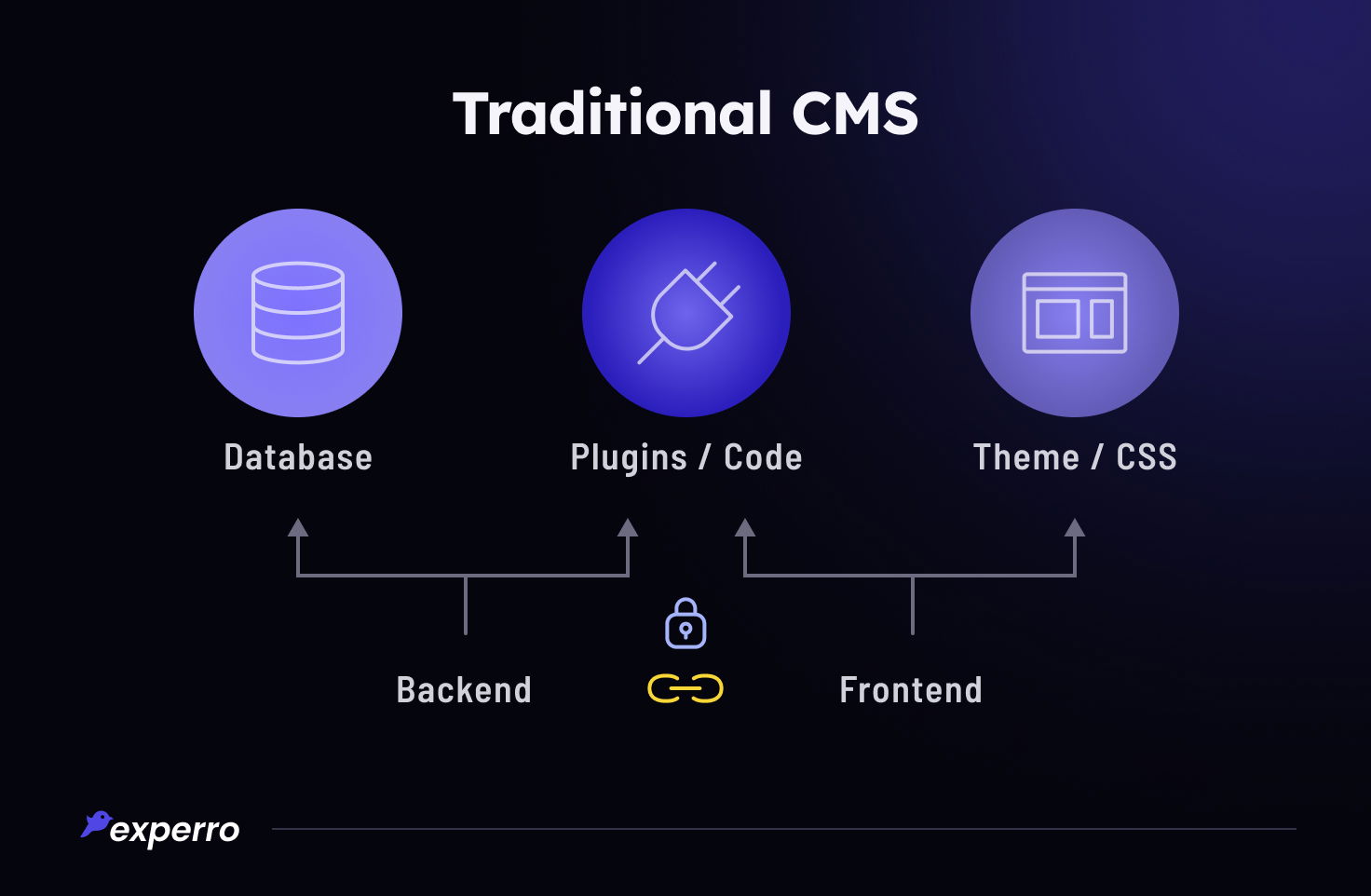
Traditional CMS is built with a monolithic architecture, where the frontend (presentation layer) and backend (content library) are tightly coupled. This means making any changes to the frontend will affect the backend too.
Since the traditional CMS approach links content creation and presentation, it simplifies website management. But when it comes to editing content, it demands much time and effort from the development team.
Why Traditional CMS Lacks Flexibility?
Traditional CMS often have a predefined structure and architecture that limits customization options. So, when it comes to editing and delivering content on various digital channels, traditional CMS pose limitations.
Pros and Cons of Traditional CMS
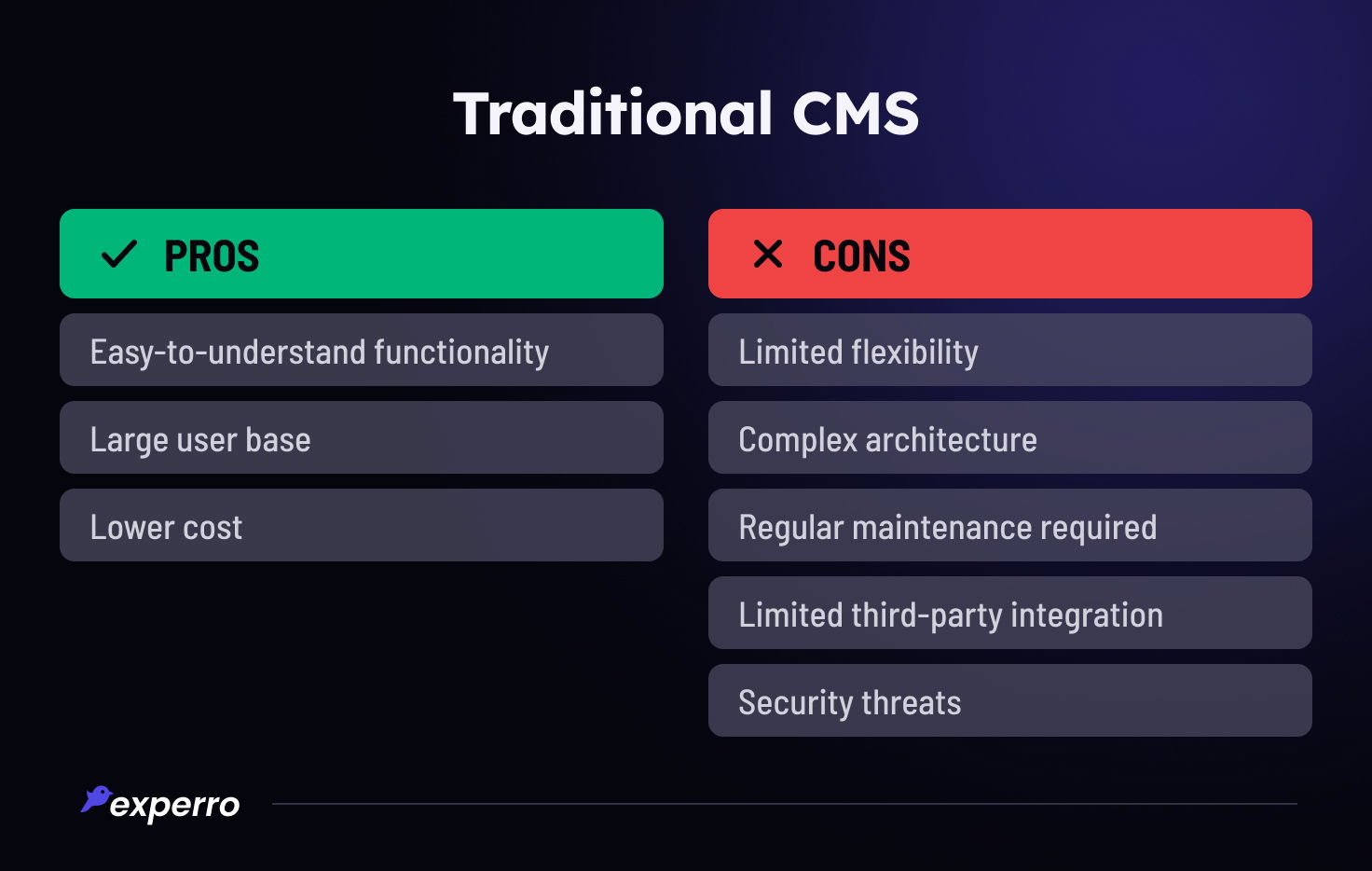
To understand the comparison between traditional vs headless CMS, thoroughly, we must analyze its pros and cons.
Let's understand the pros and cons of traditional CMS platforms first.
Pros of Traditional CMS
Traditional CMS platforms offer some benefits that might make them a valid choice for certain businesses.
- Easy to manage website architecture with an intuitive interface. It allows businesses to manage websites without extensive expertise.
- Larger user base and vast community of developers.
- Comparatively lower cost structure.
- Perfect solution for the individual who wants to build their own website.
Cons of Traditional CMS
While traditional CMS platforms are easy to use, they come with following drawbacks:
- Lacks flexibility in delivering content on multiple digital channels such as mobile apps, social media and smart devices.
- Requires technical knowledge for advanced customization and development.
- Poses Security threats due to tightly linked backend and frontend.
- Doesn't align with the growing customer demand in a digital landscape due to its rigid architecture.
- Limited integration with third-party tools makes it less future-proof in today's changing digital landscape.
- Requires time and effort for regular maintenance to avoid potential vulnerabilities.
When To Adopt Traditional CMS?
Even though traditional CMS lacks flexibility, its requirement depends upon your organization's specific goals. Traditional CMS can fit best for you if you align with the following categories:
1. Small To Medium-Sized Enterprises
Traditional CMS platforms are often more user-friendly and easier to set up. They provide a range of prebuilt templates, themes, and plugins that enable businesses to access these resources quickly.
A traditional CMS can be a suitable choice if your business has simple content management needs and doesn't require advanced customization or integration capabilities.
2. Non-profit Organizations with a Limited Budget
Non-profit organizations often operate with limited financial resources. Traditional CMS platforms often offer cost-effective solutions for budget-friendly needs. These platforms allow non-profit organizations to create and maintain their websites within budget constraints.
3. Individuals Wanting to Build Their Website
Traditional CMS platforms are well-suited for individuals who want to create websites without extensive programming knowledge. These platforms typically offer intuitive user interfaces, drag-and-drop functionality, and a wide range of templates and themes.
Traditional CMS Examples
Below are some popular examples of traditional CMS platforms:
1. Drupal
Drupal is a free, open-source traditional CMS platform that builds everything from blogs to websites and applications. Sufficient technical knowledge is required to use Drupal due to its integrated features and difficult-to-understand functionality.
2. WordPress
WordPress is the most used traditional CMS platform paired with MySQL or MariaDB database. Individuals use WordPress for creating blogs and simple websites. Moreover, WordPress has a prebuilt library of themes and plugins.
3. Joomla
Joomla is an open-source traditional CMS platform, which relies on MySQL for its database. Joomla is used for creating community-based websites, social networks, and eCommerce sites. With the increased popularity of Joomla, it introduced multiple extensive plugin options.
Headless CMS – A Holistic Solution for Content Management
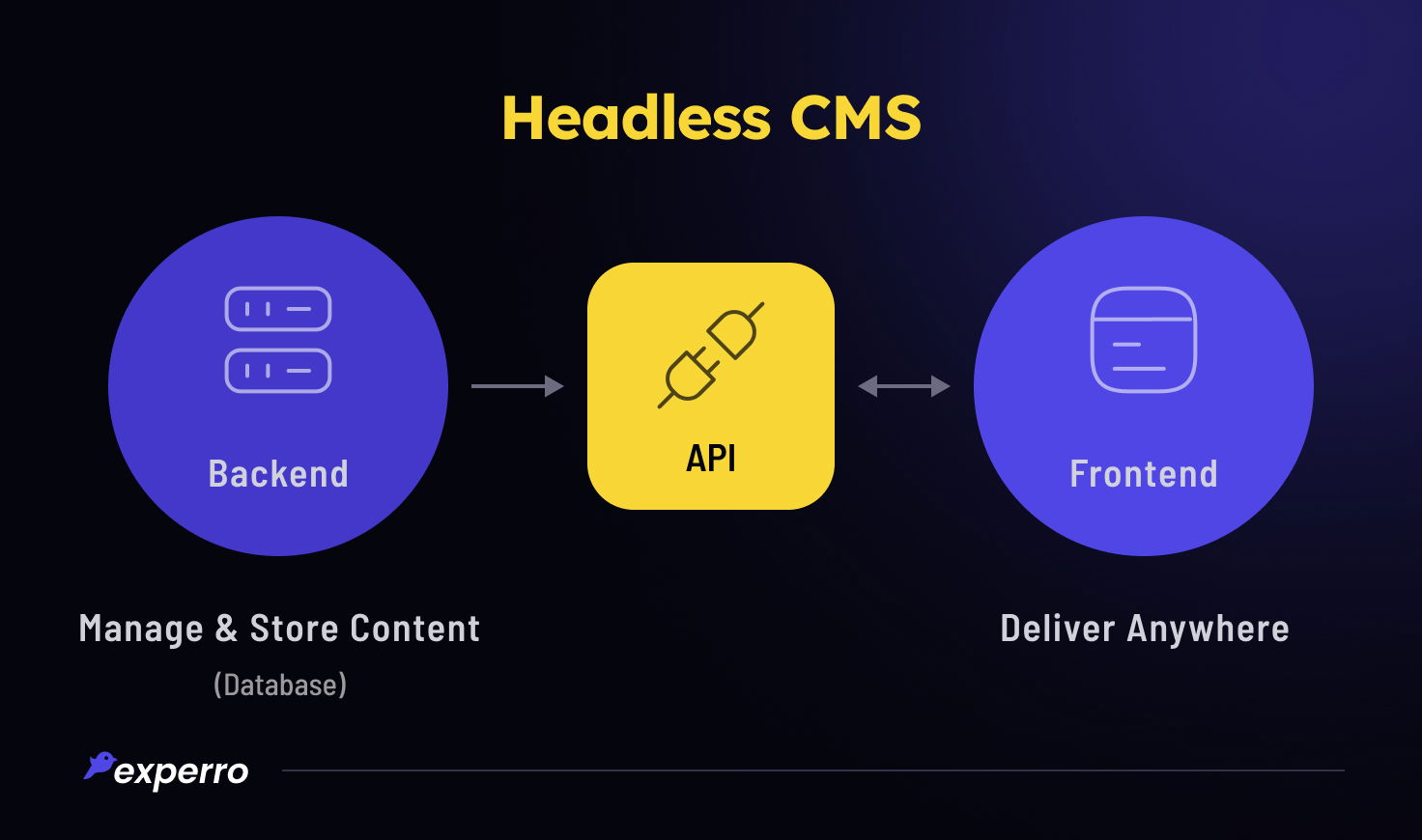
Did you know? The global headless CMS market is expected to reach nearly $597 million by 2028.
Over recent years, digital experience channels have increased rapidly. With the evolving digital landscape, customers' needs and behaviors are quickly changing. With that, the highly customer-centric approach called a headless content management system, came into the picture.
The headless approach of CMS separates the head (frontend part of the website) from its body (backend of the website). As the head, aka frontend, is removed, developers can change the content according to the users' changing demands.
Pros and Cons of Headless CMS
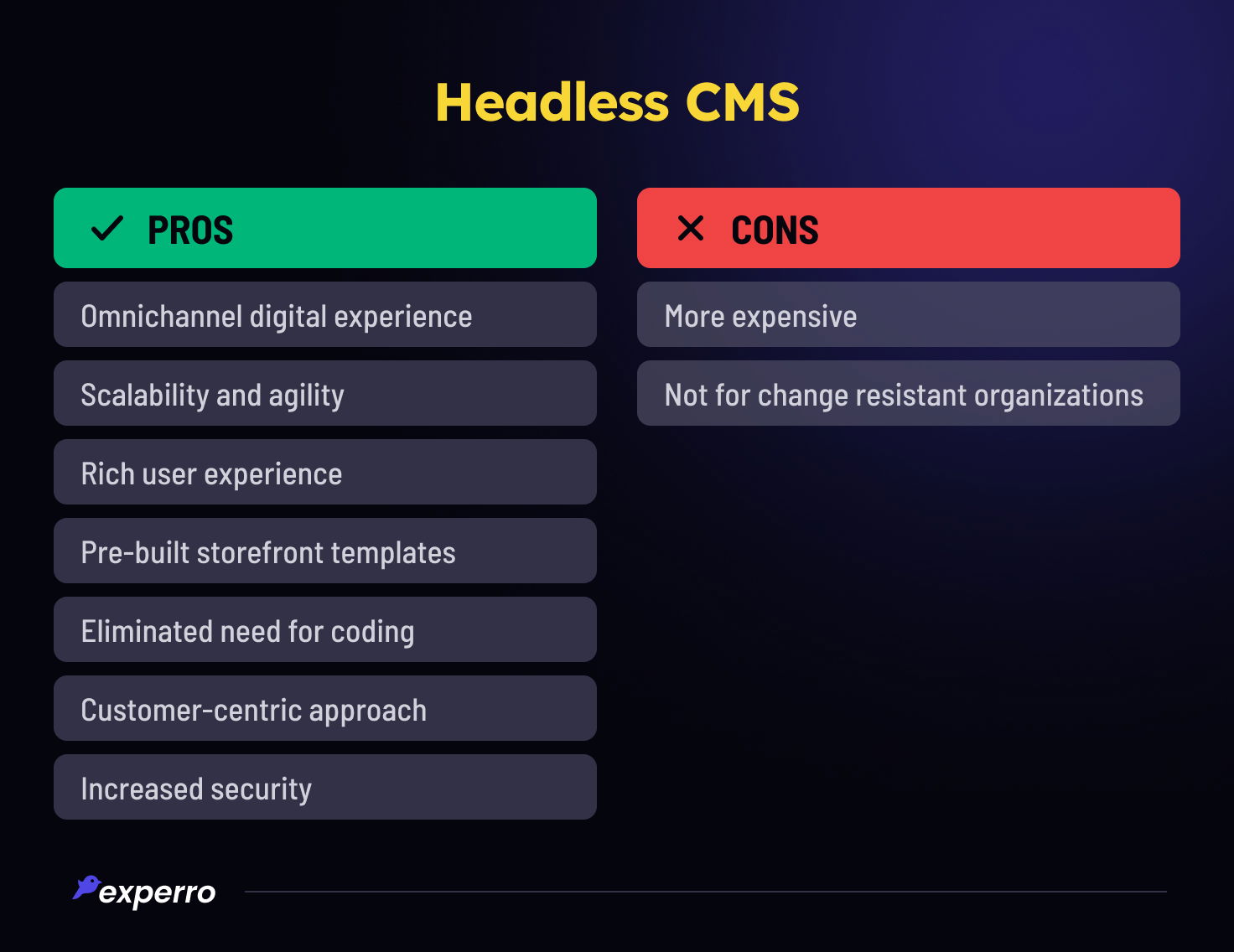
To make an informed decision between legacy CMS vs headless CMS, you must analyze the pros and cons of both. Let's dive into numerous advantages headless CMS offers:
Pros of Headless CMS
The headless approach of CMS offers compelling advantages that makes it perfect fit for the modern digital landscape. Following are the key pros of headless CMS:
- The separated backend and frontend of headless architecture provide flexibility in editing content.
- The headless CMS's API (Application Programming Interface) driven approach enables effortless omnichannel content delivery.
- Modular content approach of headless CMS enables effortless content reusability.
- Easy integration with third-party applications.
- Headless CMS makes it easy to edit and deliver content for non-technical users.
- Headless CMS enables a high degree of personalization to empower composable commerce.
Cons of Headless CMS
Headless CMS doesn't offer many cons other than the following:
- Headless CMS are expensive as compared to monolithic systems.
- Not made for change-resistant organizations.
When To Adopt Headless CMS?
Knowing when to adopt a headless approach is important as it allows you to make a well-considered choice about your technological requirements. The following are important reasons to adopt headless CMS:
1. Future-Proofing and Flexibility
If we compare headless CMS with legacy CMS, headless architecture offers greater flexibility and futureproofing than traditional monolithic CMS platforms. You can integrate with third-party applications as technology evolves, and new channels or devices emerge.
2. Enhanced Scalability
An alarming stat says that the user bounce rate will likely increase by 32% when a page loading time goes to 3 seconds.
Headless CMS solutions are known for their scalability and performance advantages. By separating the content management from the content presentation layer, organizations can scale each component independently to handle high traffic volumes and deliver faster load times.
Scalability is important for websites or applications that experience rapid growth or have high-performance requirements.
3. Easy Integration with Third-Party Applications
Headless CMS platforms can facilitate these integrations if you need to integrate your website with various third-party services or platforms, such as eCommerce systems, marketing automation tools, and CRM systems.
Moreover, it provides an API-driven approach, allowing seamless data exchange and integration between different systems.
4. Omni-channel content delivery
A total of 60% of millennials expect brands to deliver omnichannel content.
If you need to deliver content across multiple channels and devices, such as websites, mobile applications, and social media channels.
In that case, a headless approach can provide the flexibility to deploy content over various digital touchpoints. The effortless omnichannel content delivery ensures wider reach and increases brand visibility.
Headless CMS examples
For a comprehensive CMS comparison, we have curated the list of top headless CMS platforms below:
1. Experro
If you are on a journey to create a tailored customer experience through high-quality content, then Experro is the one for you. Experro has collaborated with several merchants around the world to upscale their businesses.
It provides an incredible digital experience to its customers with a headless approach and a set of integrated features. The best thing is it caters to all eCommerce brands B2B, B2C, and D2C.
Experro offers easy integration of third-party apps such as google ads, Zoho, Pipedrive, Azure, google cloud platform, Salesforce, and many more.
The headless eCommerce approach of Experro is developer friendly and enables ultra-fast delivery of content compatible with the modern landscape. Moreover, it builds magnificent storefronts for blazing-fast eCommerce.
2. Strapi
Strapi is another popular headless CMS platform and is 100% Java script. It has a set of features for managing content types, roles, and permission. Strapi offers a marketplace for plugins where you can create your choice.
3. Contentful
Contentful is also a popular headless content management platform founded in 2013. It is designed with API first approach making it easy to deliver content on various platforms. There is no premade content model of contentful so that you can design according to your needs.
Its intuitive user interface provides a great experience for its customers. Contentful usage needs less support from IT so that it can be accessed seamlessly. Its 25-day window recovery stores and secures all the data of the website.
Interesting pick for your business - D2C vs B2C eCommerce: Which is Better?
Traditional CMS Vs Headless CMS Comparison
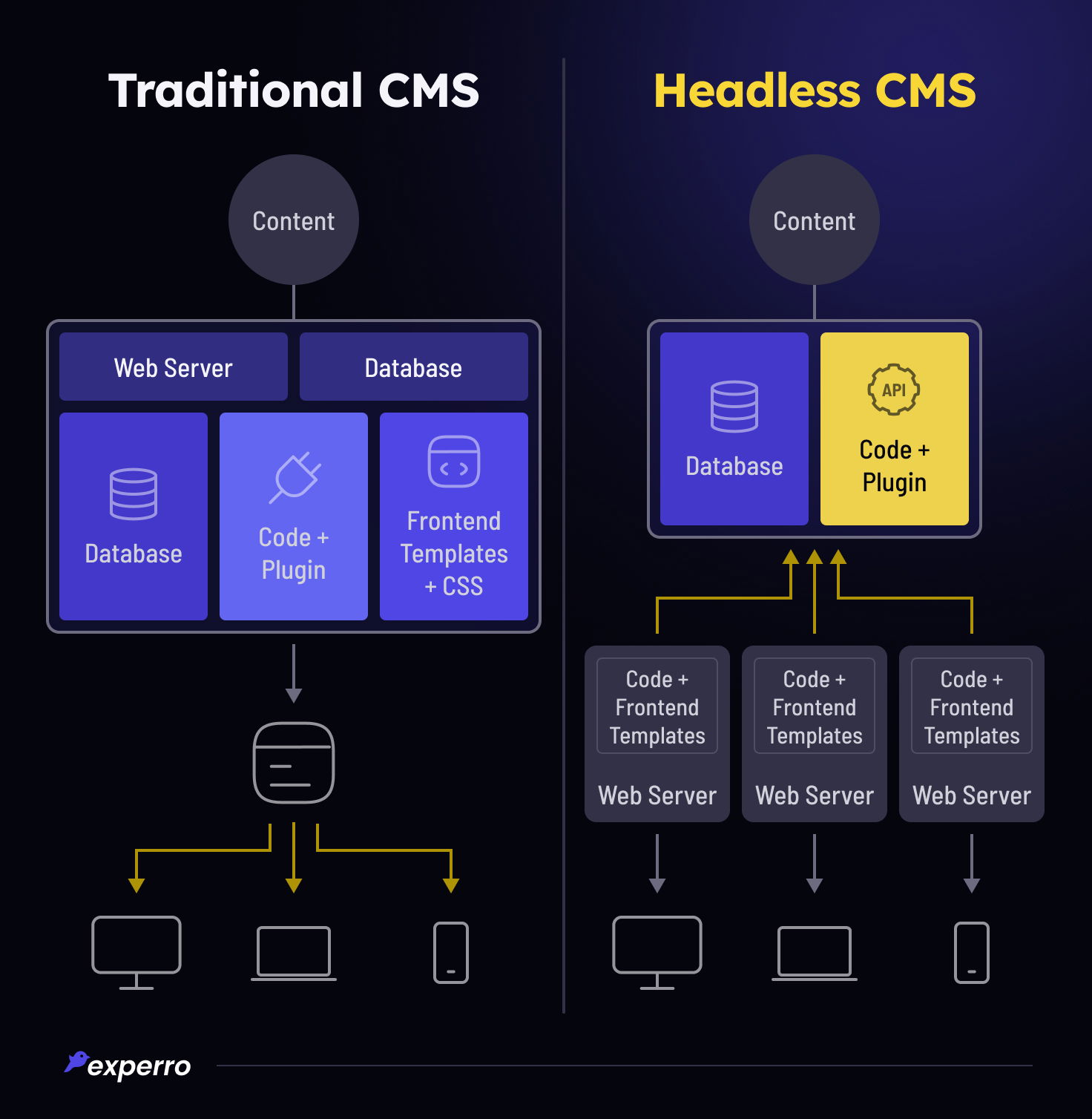
Below table explains the comparison and throws light on the difference between traditional and headless CMS.
Basis of Distinction | Traditional CMS | Headless CMS |
|---|---|---|
| Architecture | Tightly coupled frontend and backend | Completely separated frontend and backend |
| Omnichannel Capability | Unable to deliver content on multiple platforms | Seamlessly delivers content on multiple platforms |
| Customization | Customizable to some extend | Highly customizable |
| Third-party Integration | Limited integration with third-party apps | Easy integration with third-party apps |
| Page Loading | Slow page loading might occur in high traffic | No downtime even in the high traffic |
| Personalization | Limited personalized content delivery | Delivers highly personalized content |
| Security | Threat in one area can compromise the entire system | Decoupled architecture makes it less vulnerable |
| APIs | Extensive plugin options | Decoupled architecture makes it less vulnerable |
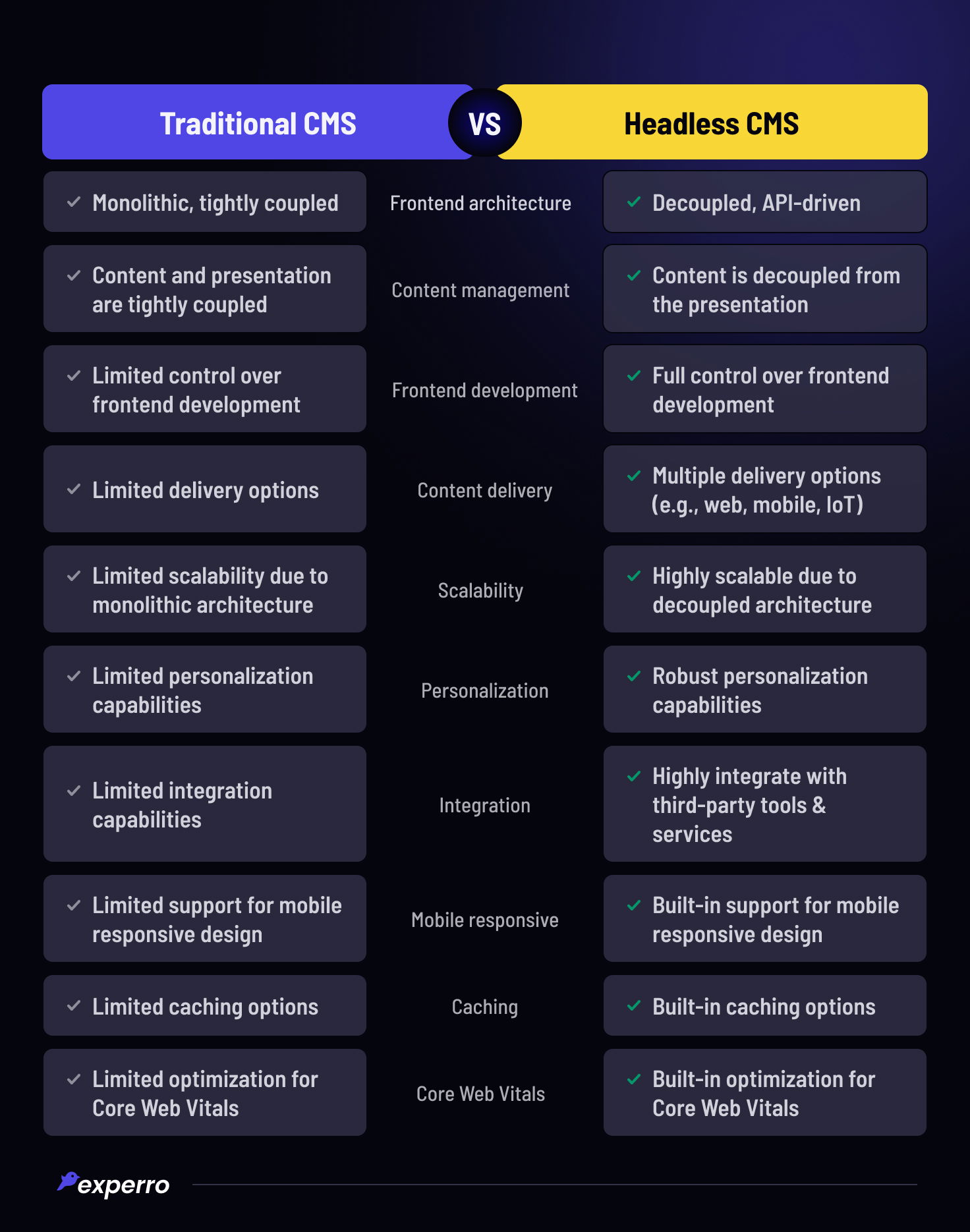
Wrapping Up!
Although the choice between a headless CMS vs traditional CMS comes down to the business's specific requirements but with the extensive need for a customer-centric approach in businesses, the future is headless.
However, the question remains what do the traditional website owners do to make a switch and still not lose anything from their old monolithic website?
The solution is that they can experience the best of both worlds if they know how to integrate hybrid CMS in their current business websites. This can enhance the quantity of your website traffic with the combined capabilities.
Book a demo with Experro today to experience smooth and powerful transformation for your website.
FAQs


Priya Zala
14 June 2024Through her writing, she has a lovely way of capturing users' pain points and delivering solution-oriented content. Her writing is sure to captivate readers and leave them with a lasting impression. When not crafting content, Priya enjoys getting lost in a good work of fiction, which soothes her soul.